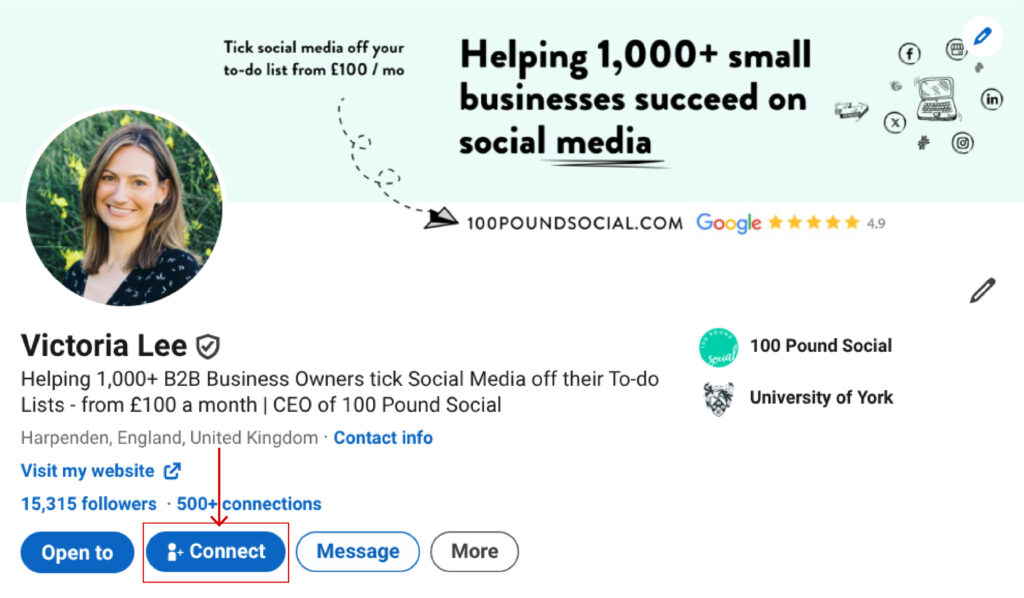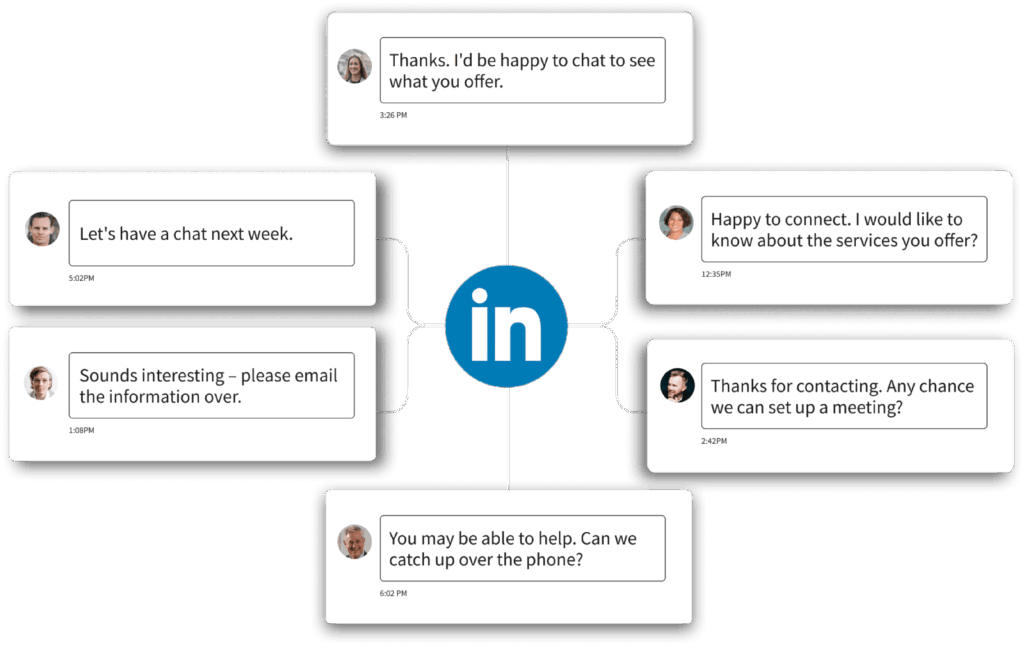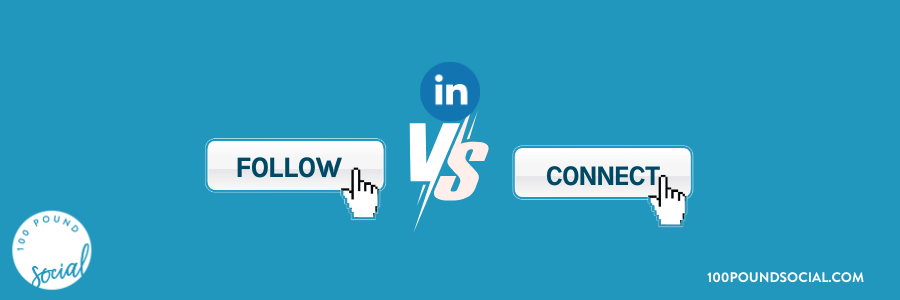LinkedIn has become an indispensable platform for B2B business growth, serving as a digital hub where professionals connect, engage, and build meaningful relationships that drive commercial success.
With its business-oriented user base and robust suite of tools—from content sharing and lead generation to advanced analytics—LinkedIn empowers companies to reach decision-makers, establish thought leadership, and build trust with potential clients.
Yet, as small businesses and entrepreneurs enter LinkedIn’s ecosystem, a common point of confusion arises: what’s the difference between “Follow” and “Connect,” and how should each be used to maximise the results from your B2B LinkedIn strategy? This comprehensive guide, LinkedIn Follow vs Connect explained, will help you understand which approach drives better results for your business.
Understanding these two fundamental actions can make the difference between building a superficial online presence and creating a network that generates real business results.
Let’s break down each approach and examine how small B2B businesses can strategically use both to accelerate their growth.
LinkedIn Connect Explained: What It Means for B2B Networking

How Connections Work
A LinkedIn connection represents a two-way relationship.
When you connect with someone, both parties must agree to the connection, signifying mutual recognition or trust. Once accepted, you become “1st-degree connections,” which provides several valuable features:
You and your connection see each other’s posts and updates in your feeds, creating ongoing visibility. Direct messaging becomes available, opening the door for private conversations about business opportunities, partnerships, or collaborations.
Both parties can endorse each other’s skills and leave recommendations, adding credibility to your profiles. Access to each other’s contact information is granted, facilitating deeper business relationships.
Mutual Visibility and Messaging
Connections are designed for people you know or wish to build a professional relationship with.
This mutual relationship creates opportunities for direct messaging, which proves invaluable for business development, sales outreach, or partnership discussions. You gain visibility into each other’s activities, including likes, comments, and shares, which helps you stay informed about your network’s interests and challenges.
The ability to collaborate more closely and access each other’s networks often leads to introductions and referrals.
Pros and Cons for Small Businesses
The advantages of connections include enabling direct, personalised communication that can lead to immediate business opportunities.
A quality network of connections builds credibility—having respected professionals in your network signals trustworthiness to potential clients and partners.
Connections also facilitate referrals and introductions, which remain among the most effective ways to generate new business.
However, connections require approval, so network growth tends to be slower and more deliberate than following.
Connecting indiscriminately can dilute the quality of your network and reduce its overall value. Some users remain hesitant to accept connection requests from people they don’t know well, which can limit your reach if not approached strategically.
LinkedIn Follow Feature Explained: How It Supports Thought Leadership
Understanding how LinkedIn’s Follow feature works can help you build influence, grow your audience, and share insights more effectively.
One-Way Content Visibility
Following creates a one-way relationship. When you follow someone, you see their public posts and articles in your feed, but they don’t see your content unless they follow you back.
No approval is needed, making it a frictionless way to keep up with industry leaders, influencers, or companies whose insights can benefit your business.
When People Prefer to Follow Instead of Connect
Following works best when you want to learn from or keep up with someone without initiating a direct relationship. Many high-profile figures or influencers don’t accept connection requests from people they don’t know, making following the only way to access their content.
Following also allows you to gradually engage with someone’s content before deciding whether to pursue a connection, creating a natural progression in the relationship-building process.
Use Cases for Business Pages or Public Figures
Company pages and public figures often default to “Follow” as the primary action, allowing them to build large audiences without the need for reciprocal relationships.
This approach proves particularly effective for thought leaders and industry experts who want to share insights with a broad audience. Following also works well for brands whose insights are valuable but who may not know you personally.
LinkedIn Follow vs Connect for B2B: Which Strategy Works Best?
| Feature | Follow | Connect |
| Relationship Type | One-way | Two-way |
| Content Visibility | See their posts; they don’t see yours | Mutual |
| Direct Messaging | No (unless enabled) | Yes |
| Endorsements/References | No | Yes |
| Approval Required | No | Yes |
| Best For | Learning, thought leadership, public pages | Personal networking, business development |
When to Use Each
Use Connect when you have a direct business reason to build a relationship—such as a potential client, partner, or industry peer.
Connection requests work best when you can reference a shared experience, mutual contact, or specific business reason for connecting.
Use Follow when you want to learn from someone, keep up with their insights, or are not ready for a direct relationship. Following allows you to monitor industry trends, stay informed about potential partners or clients, and identify opportunities for future engagement.
When developing your B2B LinkedIn strategy, understanding LinkedIn Follow vs Connect is crucial for success. Consider these practical examples.
A software development agency might connect with potential clients they meet at conferences or through referrals, while following industry analysts and thought leaders to stay current on technology trends.
A business coach could connect with other coaches for partnership opportunities while following successful entrepreneurs to understand their challenges and create relevant content.
For recruitment agencies, connecting with HR directors, hiring managers, and potential candidates builds essential business relationships, while following industry publications and talent acquisition leaders provides market intelligence on hiring trends and best practices.
Service-based businesses often benefit from connecting with complementary service providers for referral opportunities, while following potential clients to understand their challenges before reaching out directly.
How Both Contribute to Visibility and Credibility
Connections build your core network and enable direct engagement. They prove essential for referrals, introductions, and private conversations that often lead to business opportunities. Your connections also expand your reach, as your content becomes visible to their networks when they engage with your posts.
Followers expand your reach and amplify your thought leadership, as your content becomes visible to a broader audience—even those outside your immediate network. The more followers you have, the wider your content’s reach, positioning you as an authority in your field.

B2B LinkedIn Strategy: Thought Leadership vs Personal Networking
When planning your B2B LinkedIn strategy, the strategic choice between Follow and Connect often depends on whether your primary goal is establishing thought leadership or building personal networking relationships—two distinct but complementary approaches to B2B growth.
Thought Leadership Strategy
Thought leadership focuses on building authority and credibility within your industry by sharing valuable insights, expertise, and perspectives. This approach primarily leverages the Follow function, as your goal is to attract a broad audience of industry professionals who value your content.
When building thought leadership, you’ll want to follow industry influencers, analysts, and publications to stay current on trends and conversations. This positions you to create timely, relevant content that demonstrates your expertise.
You’re not necessarily seeking direct relationships with these sources—you’re learning from them to enhance your own knowledge and content quality.
The Follow strategy works particularly well for thought leadership because it allows you to cast a wide net. Your followers don’t need to know you personally; they follow because they find value in your insights.
This creates opportunities to influence buying decisions even before prospects are ready for direct conversations. This LinkedIn Follow vs Connect explained approach shows why Follow works best for thought leadership goals.
Personal Networking Strategy
Personal networking, on the other hand, focuses on building direct, meaningful relationships with specific individuals who can impact your business. This approach relies heavily on strategic connections, as your goal is to develop trust and rapport that leads to opportunities, referrals, and partnerships.
When networking personally, you connect with potential clients, industry peers, complementary service providers, and referral sources. These relationships require mutual recognition and trust, making the approval-based Connect function more appropriate than the one-way Follow.
Personal networking emphasises quality over quantity. A smaller network of engaged, relevant connections often provides more business value than thousands of followers who don’t know you personally.
Understanding LinkedIn Follow vs Connect differences helps you choose the right networking approach.
Optimising Your B2B LinkedIn Strategy: Tips for Small Businesses
How to Build a Strategic Connection Strategy
As part of your B2B LinkedIn strategy, target connections strategically by focusing on decision-makers, industry peers, and potential clients rather than connecting randomly.
Create an ideal connection profile that includes specific job titles, company sizes, industries, and geographic locations that align with your business goals.
Research prospects before sending connection requests. Review their recent posts, shared content, and mutual connections to find common ground. This research enables you to craft personalised messages that significantly improve acceptance rates.
Optimising Your Profile for Follows And Connections
Turn on Creator Mode to make the “Follow” button prominent and access additional features like newsletter creation and expanded analytics.
Creator Mode provides tools that help establish thought leadership and expand your reach beyond your immediate network.
Craft a compelling headline that goes beyond your job title. Instead of “CEO at ABC Company,” try “Helping Manufacturing Companies Reduce Operational Costs by 20% Through Process Optimisation.” This approach immediately communicates your value proposition.
Use your summary section to tell your professional story, highlight your expertise, and include a clear call-to-action. Incorporate relevant keywords naturally throughout your profile to improve discoverability in LinkedIn searches.
Leveraging Content To Convert Followers Into Leads
Content Formats That Drive Business Results
Industry case studies perform exceptionally well for B2B audiences. Share specific examples of how you’ve helped clients overcome challenges, including the problem, your solution, and quantifiable results. These posts build credibility while demonstrating your capabilities to potential clients.
“Behind-the-scenes” content humanises your business and builds trust. Share your team’s problem-solving process, lessons learned from mistakes, or insights from client interactions. This transparency differentiates you from competitors who only share polished success stories.
Educational content that solves real problems positions you as a valuable resource. Create “how-to” posts, industry explainers, or trend analyses that provide immediate value to your audience. When people benefit from your free content, they’re more likely to consider your paid services.
The Relationship Nurturing Process
Engagement should follow a systematic approach: First, consistently like and comment thoughtfully on your connections’ posts. Avoid generic comments like “Great post!” Instead, add specific insights or ask relevant questions that demonstrate you’ve actually read and considered their content.
Second, share relevant content that benefits specific connections. When you find an article, report, or opportunity that would interest someone in your network, send them a brief message with the resource and explain why you thought of them.
Third, offer help before asking for anything. Look for opportunities to make introductions, share expertise, or provide resources that benefit your connections. This approach builds goodwill and positions you as a valuable network member.
Effective Follow-Up Strategies
The fortune is in the follow-up, but timing and approach matter significantly. After someone engages meaningfully with your content, wait 24-48 hours before sending a connection request or direct message. This delay feels more natural than immediate outreach.
When following up on engaged prospects, reference their specific interaction with your content. For example: “Thanks for your thoughtful comment on my post about supply chain optimisation. I’d love to learn more about the challenges you mentioned facing in your manufacturing operations.”
Create a systematic follow-up sequence for new connections:
- Day 1: Send a thank-you message for connecting
- Week 1: Share a relevant resource or industry insight
- Week 3: Check in with a question about their business
- Month 2: Offer specific help or make a relevant introduction
Converting Engagement to Sales Conversations
Look for buying signals in your interactions. When connections ask detailed questions about your services, request recommendations, or mention challenges you can solve, these indicate potential sales opportunities.
Transition from social engagement to business conversations gradually. Start by offering free value through resources, advice, or introductions. Once you’ve established trust and demonstrated expertise, suggest a brief call to discuss their specific situation.
Use soft calls-to-action that feel helpful rather than sales-focused. Instead of “Let’s schedule a sales call,” try “I’d be happy to share some insights about [their specific challenge] if you’d like to chat for 15 minutes.”
LinkedIn Follow vs Connect Explained: Summary for B2B Users
Connect when:
- You have a specific business reason for building a relationship, such as a potential client you’ve met at a networking event or through a referral
- You want to enable direct messaging for sales conversations, partnership discussions, or collaboration opportunities
- You’re building a trusted network of industry professionals who can provide referrals, introductions, or strategic advice
- You’ve identified complementary service providers who could become referral partners
- You need to access someone’s full contact information, or want the ability to endorse their skills and receive recommendations
Follow when:
- You want to learn from industry thought leaders, analysts, or publications without necessarily building a direct relationship
- You’re researching potential clients or partners and want to understand their challenges and interests before reaching out
- You’re building thought leadership and want to stay current on industry trends and conversations
- You’re engaging with high-profile figures or influencers who typically don’t accept connection requests from strangers
- You want to gradually build familiarity with someone’s content before deciding whether to pursue a deeper business relationship
The Strategic Balance: Most successful B2B businesses use both approaches simultaneously. Follow industry leaders and publications to fuel your content strategy and thought leadership, while strategically connecting with prospects, clients, and referral sources to build your core business network.
This creates a powerful combination where your thought leadership attracts potential prospects, and your personal connections provide direct access to opportunities and referrals. Mastering LinkedIn follow vs connect strategies forms the foundation of any successful B2B LinkedIn strategy.
Remember that quality trumps quantity in both cases—100 engaged, relevant connections often provide more business value than 1,000 followers who don’t know your work or industry.
Next Steps
Understanding and strategically using both “Follow” and “Connect” allows small B2B businesses to maximise their LinkedIn presence, boost credibility, and access new opportunities for growth. Effective LinkedIn marketing requires a balanced approach that combines relationship building with thought leadership.
Finally, remember that LinkedIn success doesn’t happen overnight.
Consistent engagement, valuable content creation, and strategic relationship building compound over time to create a powerful platform for B2B growth. Whether you’re connecting with potential clients or following industry leaders, each interaction contributes to building your professional brand and expanding your business opportunities.
100 Pound Social’s LinkedIn Lead Gen service
While building your own LinkedIn network organically provides long-term value, many small B2B businesses need faster results to meet immediate growth targets.
If you’re looking to systematically generate qualified leads from LinkedIn without spending hours daily on outreach, consider leveraging a proven lead generation service.
Services like 100 Pound Social’s LinkedIn Lead Generation plan use data-driven approaches to identify and engage your ideal prospects systematically. Rather than hoping your content reaches the right people, professional lead generation services actively target decision-makers in your ideal client profile.
Here at 100 Pound Social, over the last 7+ years, we’ve helped 1000+ B2B companies to build large connection bases and generate hot leads on LinkedIn. Book a call today, or join a free 11-minute demo to find out how we can help your business do the same.



